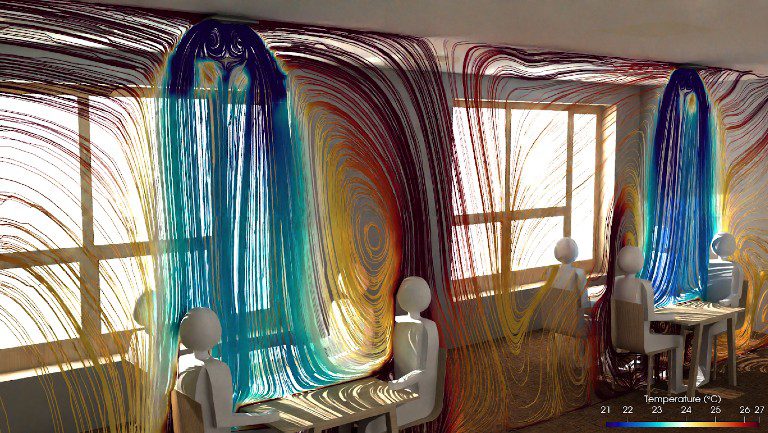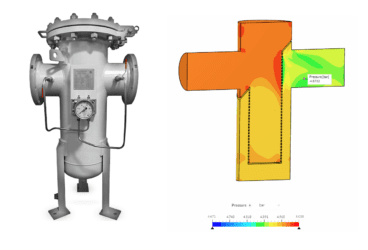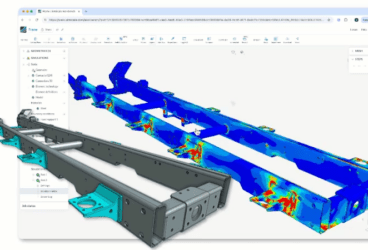The COVID-19 pandemic has created such significant change in the world that the measures taken to combat it’s social, economic, and health impacts have been compared to warlike mobilization on a global scale. Despite news of pending vaccines, many countries are reporting an increase in positive test cases and excess deaths, indicating the threat is far from over. Many observers have commented that the pandemic has forced a permanent change in the way people live, work, shop, and socialize in a very short time-frame. The built environment sector has been impacted heavily. Those who can work from home are realizing the many benefits of saving time and money. For example, companies are saving money on expensive rents in the commercial real estate sector, and landlords and developers have been forced to rethink their business models. Schools, restaurants, offices, and other types of buildings are working hard to adapt to the changing circumstances by making their spaces ‘COVID-safe’ to reassure occupant and public safety. Ventilation plays a vital part in this COVID-19 management strategy. This article covers ventilation strategy design considerations for offices, restaurants, and classrooms and explains how simulation can help designers achieve adequate ventilation.
COVID-19 and Ventilation Strategy: Why CFD Simulation Is So Important
Understanding respiratory transmission dynamics and risk factors can help us design ventilation strategies in buildings more effectively. The dynamics of transmission have three primary parameters:
- Source —a cough or a sneeze, for example. The location and duration of the original ‘event’ must be understood, as well as its composition (size of particles, droplets, moisture content, trajectory).
- Transport and Deposition —how the source material is transported in space and where it is deposited. This is highly dependent on the room airflow distribution and movement. The HVAC and any natural ventilation further influence this through windows, infiltration, and occupant behavior. Understanding a detailed view of the room airflow characteristics is, therefore, critical for adequate ventilation and covered in further detail below.
- Exposure —how an occupant is exposed to the source material. This could be as an aerosol, thus inhaled, and is considered to be the primary mechanism of exposure leading to potential transmission. Larger (heavier) droplets and surface contacts from fomites can also be significant contributors to exposure, although these are not as well-understood.
It is clear that the two most important variables are transport and aerosol behavior, both a function of airflow, thus making them exceptional candidates for further analysis by computational fluid dynamics (CFD).
Let us consider the risk factors that contribute to someone catching a virus:
- Proximity — the risk of exposure increases with closer proximity to others.
- Enclosure — the risk indoors increases relative to deficient ventilation.
- Duration — the longer someone is exposed to an infected person, the more likely they are to become infected.
- Activity — physical activities that increase metabolic activity and, hence, breathing rate increase the risk of exposure, especially when indoors.
- Crowding — the risk is proportional to the number of people in your proximity.
- Environmental Conditions — viruses typically survive longest in cooler, drier, and darker conditions.
- Symptoms — infected persons might not show any visible signs of infection, therefore judging crowding and proximity becomes difficult.
From the list of risk factors above, CFD simulations can account for the first six factors as described in Table 1. It is worth noting that the physics involved can be complex. A very detailed assessment might also consider that exhaled coughs, for example, behave like Gaussian plumes that interact with the thermal behavior of the occupant breathing. Furthermore, droplet and advanced treatment of moisture content (including phase change) are all physics that are present and should be considered for highly detailed assessments. The aim of the simulation must be clear before embarking on any type of CFD. This article highlights the usefulness of CFD in comparing relative scenarios to give a quick and accurate assessment for building owners, engineers, and ventilation specialists, that they might adapt current buildings or designs with a reasonable level of confidence.
| Risk Factor | Input to CFD Simulation | Useful Outputs |
| Proximity | Physical distance between simulated occupants | Airflow in/around occupants, distance of a cough/sneeze |
| Enclosure | A 3D model of the room/buildings with occupants and with windows, HVAC, and construction (thermal) data applied to the model | Airflow distribution around the room, air velocities, and temperatures and how it interacts with occupants |
| Duration | A transient analysis of a cough/sneeze and using a passive scalar to calculate mean age of air | Time for airflow to mix in the room, mean age of air in the space |
| Activity | Adding various metabolic rates to occupants and, hence, increasing CO2 generation | CO2 as a measure of air quality |
| Crowding | Multiple occupant densities | Impact of air distribution and mean age of air by varying number of occupants, ‘dead spots’ for ventilation with little or no mixing |
| Environmental Conditions | Specific ambient temperature, supply air temperature, flow rate, account for humidity, and external wind and climate | How varying external climate conditions impact the indoor space |
From a ventilation perspective, and those outputs useful for COVID-19 mitigation strategies, the following become key metrics for any comparative study, all of which are available from CFD:
- Whole room ventilation rates (ACH, mean age of air)
- Fresh air and fresh air ratio
- Placement of air supply and exhaust grills
- The air velocities and air mixing in close proximity to the occupants
Let us consider three types of spaces to understand how the risk factors above apply in each case and why CFD simulation is essential in understanding ventilation system design.
Ventilation Strategy for Restaurants
A restaurant is an enclosed space where diners sit in close proximity not only to occupants at their table but to other diners as well. It is an indoor environment with high levels of talking and socializing. Food and drink are consumed and prepared, sometimes in open kitchens. Because of the specific ventilation requirements of cooking and food preparation, the flow of air is heavily influenced by the commercial-scale extractor fans that induce a negative pressure inside the restaurant. Any slight opening of a front door and air rushes in. Many higher-end restaurants are air-conditioned in summer. There is also a higher potential of transmission from surfaces and contact with objects such as plates, crockery, and drinking glasses. Restaurant ventilation is not typically designed for a high level of fresh air. Many of the risk factors including crowding, duration, and proximity apply. CFD can visualize the flow of air in and around the restaurants and illustrate how this is influenced by mechanical fans. One can also see the interaction of the main air flows with diners and the effect of altering these air currents. This will assist in knowing where to place the tables and diners to ensure an optimal airflow strategy to minimize the main risk factors.
Ventilation Strategy for Offices
Offices, whether open-plan or with cubicles, are subject to crowding and proximity. Many are air-conditioned spaces all year round, with little fresh air mixing. Recently, advanced in-office ventilation research has focused on the impact of air quality on productivity and wellness, creating a stronger appreciation for the importance of ventilation. Many occupants work in an enclosed space for most of the day. Office ventilation must consider the impact of duration as a primary risk factor. Because occupants are subject to the office environment for most of the day and week, the risk of transmission is high. Meetings and small meeting spaces will compound this risk as do narrow corridors and common areas. CFD is used to visualize the main airflow distribution pattern due to mechanical supply and extract systems and understand how they interact with openable windows. Simulation demonstrates airflow interacting with occupants/desks and shows the impact of changing supply flow rates and different openable window configurations. A passive scalar introduced into the room can also visualize the spatial distribution of CO2 and predict the ventilation effectiveness in the room.
Ventilation Strategy for Classrooms
A classroom is a place of learning. Many studies have shown the impact of fresh air and good air quality on cognitive development and exam success. School design guidelines, like the BB101 Guide in the UK, will have prescriptive levels of minimum fresh air and CO2 that are required within a learning environment. The standards will also specify “never exceed” limits on internal temperatures and air quality. Most schools, however, have little or no ventilation controls as they are naturally ventilated via openable windows. Though recent trends in school design are adding mixed-mode ventilation units in the classroom which afford more control of the indoor space, the majority of existing schools remain naturally ventilated, and thus require ventilation strategy optimization. Prospects for refitting are low due to cost and funding issues. Classroom ventilation is thus extremely limited, making simulation even more important to inform window opening strategies and classroom layout. The presence of drafts and thermally uncomfortable air velocities can also be evaluated.
A CFD Template for Ventilation Strategies
Figure 1 shows a 3D model of a generic room layout that can be adapted to represent a classroom, office, or restaurant environment. The physical and thermal characteristics of the construction have been modeled, such as U-values, glazing parameters, and accurate physical sizes. This model shows an internal room layout with four tables, each with four occupants. There are operable windows on the two long facades and four roof supply/extract diffusers. These diffusers can either be set as supply diffusers, extract diffusers, or as a natural convection boundary, allowing balanced ventilation (the pressure through the opening adjusts accordingly). Occupants and lighting generate internal sensible heat gains and solar gain can be applied in W/m2 to any glazed surface. The CAD model is sufficiently adaptable to add or remove occupants, heat gains, thermal and ventilation inputs, and run multiple configurations. SimScale can run dozens, if not more, simulations in parallel on the cloud.

In the example below, a supply fresh air rate of 10 l/s/person at ambient temperature, has been supplied through the four diffusers (total of 160 l/s). Figure 2 shows that the mean age of air is 700 seconds, just under 12 minutes. Figures 3 and 4 illustrate temperature contours in the space and around the occupants and finally, Figure 5, shows the velocity contours at a 1.2 m working height. A user wishing to explore the movement of air and thermal comfort in a space can use CFD to optimize a ventilation design and space layout. The outputs presented here can aid an engineer to assess the ventilation effectiveness of a space by simulating for the mean age of air and visualizing the flow field. A higher mean age of air indicates poorer ventilation. The flow of air around an occupant is also important. Various configurations of mechanical supply and window openings will alter the flow and thermal properties within a space. This means that each new configuration must be simulated. Fortunately, with SimScale on the cloud, dozens of scenarios can be modeled in parallel.
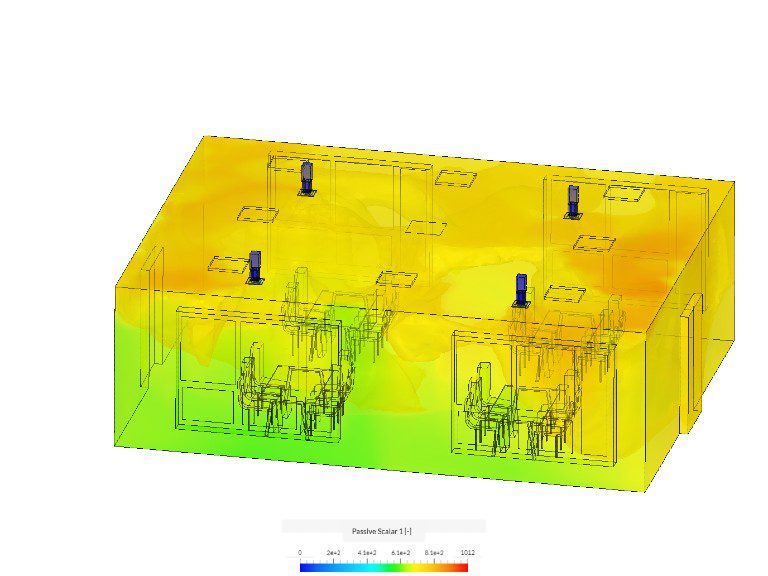
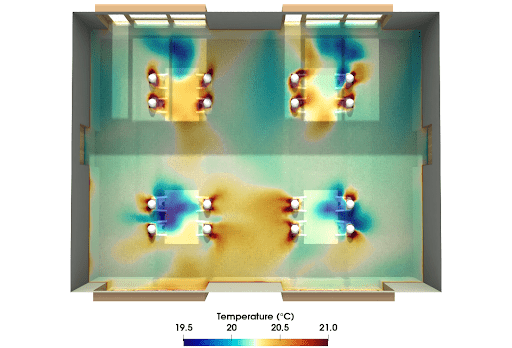
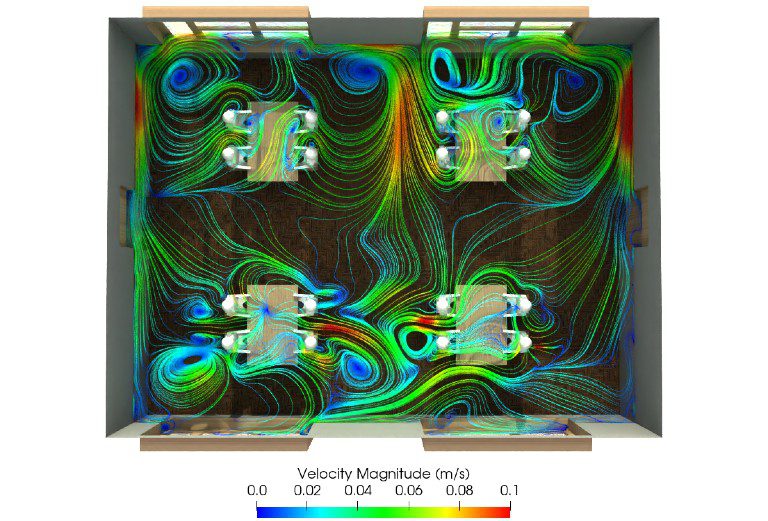
Figure 6 shows a new CAD scenario (Scenario 1) with open windows at 2.5% of floor to window opening ratio. The top-hung windows on one facade are slightly open to give an opening area of 1.7 m2. Figure 7 shows the side-by-side comparison of airflow distributions at a 1.2 m height in the room. The difference between the two is significant and shows how sensitive the air in a room is to even minor room changes. In Scenario 1, the mean age of air is now 12 minutes (Reduced from 20 minutes for the baseline scenario).
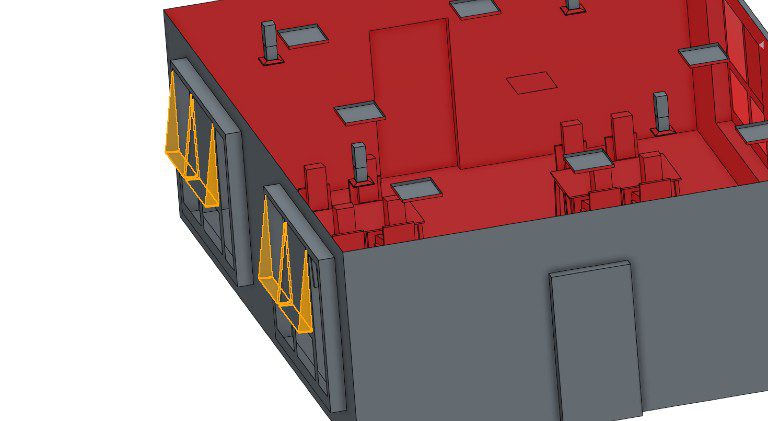
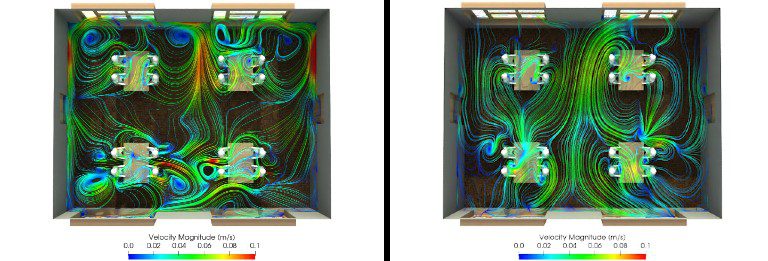
Conclusion
Simulation can ensure sufficient ventilation is achieved in restaurants, offices, and classrooms and, therefore, enable more informed decision-making when attempting to manage infection rates of COVID-19 in indoor spaces. Using SimScale we have modeled hundreds of window opening strategies and configurations with and without supply and extract air diffusers. CFD simulation can be used to test ventilation strategies of large and complex structures, as well. Read our Mott MacDonald case study on natural ventilation simulation for a sports stadium. This ability is useful not only for the design of new buildings but also when considering refurbishment and mitigation strategies for existing buildings.
Additional Resources on Ventilation Strategy and CFD Simulation From SimScale:
- How to Optimize Displacement Ventilation Design with CFD
- Validating Passive Ventilation in Building Design with Fluid Flow Simulation
- Stack Ventilation & Bernoulli’s Principle | Passive Ventilation
